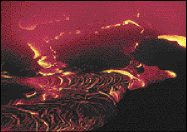Passive IR Spectroscopy Monitors Volcanic Gases
One of the most a ctive volcanoes in the world could provide researchers with important insights into processes deep within the Earth and lead to more accurate forecasts of eruptions.
The problem with studying volcanic gases is the need for direct sampling, often performed inside the volcanic crater -- a dangerous and often fatal operation. An alternative is using spectroscopy from an aircraft or the rim of a crater. Even though these distances are somewhat safer, lives would be in peril if a full-scale eruption were to occur.
Researchers from Los Alamos National Laboratory in New Mexico have developed several techniques to expand the range of passive IR spectroscopy to accurately measure gases from more than 17 km away. They've performed experiments on the recently reawakened PopocatEpetl volcano outside of Mexico City. The techniques, which are published in the Dec. 10, 1998, issue of Nature, include one using a modified Fourier-transform infrared spectrometer to contrast a clear sky with thermal emissions from the gases.
LATEST NEWS
- The Winds of Change Are Blowing Through the Photonics Industry May 3, 2024
- PsiQuantum to Build Utility-Scale Quantum Computer in Australia May 3, 2024
- Tyndall, MIT Partner on Sustainable Chip Production Processes: Week in Brief: 5/3/24 May 3, 2024
- Headwall Taps Jim Gareau to Lead Optical Components and Assemblies Unit May 2, 2024
- Cognex Names Former Siemens VP Dennis Fehr CFO May 2, 2024
- 3D Holography Integrated Glasses Could Unlock Mixed Reality May 2, 2024
- Generative AI Achieves Superresolution with Minimal Tuning May 2, 2024
- AmeriCOM Adds President and CEO: People in the News: 5/1/24 May 1, 2024
